Using Holocene paleo-fire records to estimate carbon stock vulnerabilities in Hudson Bay Lowlands peatlands
Abstract
1. Introduction
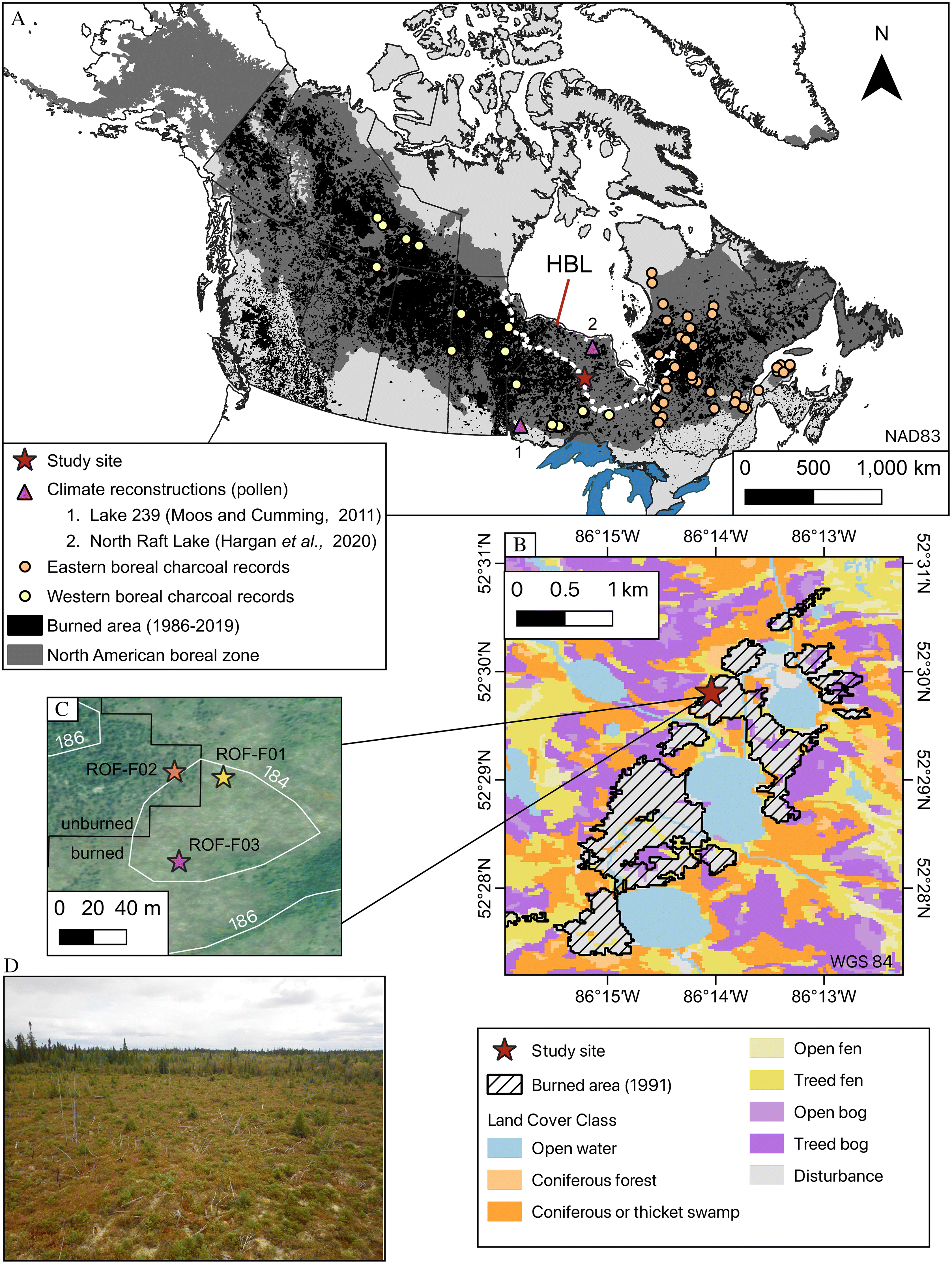
2. Methods
2.1. Study region and sampling
| Core | ROF-F01 | ROF-F02 | ROF-F03 | |
|---|---|---|---|---|
| A. Site information | ||||
| Latitude (°N) | 52.4967 | 52.4968 | 52.4960 | |
| Longitude (°W) | 86.2336 | 86.2340 | 86.2340 | |
| Microtopography at core location | Low hummock | Hollow | High hummock | |
| Location description | Burned-edge | Unburned | Burned-center | |
| Basal peat depth (cm) | 91 | 130 | 135 | |
| Basal age (cal yr BP) | 6500 | 5600 | 7200 | |
| B. CharAnalysis inputs and Holocene fire patterns | ||||
| Core interval | A | B | — | — |
| Age interval | 0–440 | 2900–6500 | — | — |
| Charcoal median sampling resolution (yrs) | 17 | 73 | 55 | 38 |
| Smoothing window (yrs) | 500 | 2200 | 1700 | 1200 |
| Threshold | Global | Local | Local | local |
| Median SNI | 45.6 | 13.0 | 12.9 | 6.5 |
| Samples SNI >3 | — | 51/51 | 104/104 | 167/196 |
| Number of peaks | 2 | 3 | 5 | 9 |
| Number of fires | 6 | 5 | 9 | |
| Number of peaks with smoldering evidence | 4 | 3 | 3 | |
| Number of FRI | 4 | 4 | 8 | |
| Mean Holocene FRI (yr·fire−1) | 930 | 990 | 907 | |
| Mean Holocene fire freq. (# 1000 yr−1) | 1.1 | 1.0 | 1.1 | |
| C. Mean peat properties and net carbon accumulation and release estimates | ||||
| Mean C content (± SD; %) | 46 ± 4 | 44 ± 3 | 43 ± 4 | |
| Mean N content (± SD; %) | 0.8 ± 0.3 | 0.7 ± 0.2 | 1.0 ± 0.3 | |
| Mean C:N ratio (± SD) | 64 ± 20 | 69 ± 19 | 49 ± 14 | |
| Mean carbon density (± SD; kg C m−3) | 57 ± 32 | 47 ± 23 | 55 ± 22 | |
| Total carbon mass (kg C m−2) | 53 | 60 | 76 | |
| LORCA (g C m−2·yr−1) | 8.1 | 10.8 | 10.3 | |
| Holocene carbon loss from fire (kg C m−2) | 10 | 8 | 11 | |
2.2. Chronology and peat properties
| Depth (cm) | Radiocarbon age (14C yr. BP) | Material | Cal BP (2σ range) | Lab ID |
|---|---|---|---|---|
| A. ROF-F01 | ||||
| 15–16 | > modern F14C: 1.7387 ± 0.0058 | Sphagnum stems and leaves | 1963–1966 (95.4%) AD | UOC-14867 |
| 35–36 | 79 ± 26 | Sphagnum stems and leaves Conifer needles | 257–224 (26.5%) 140–32 (69.0%) | UOC-14868 |
| 25–26 | 154 ± 27 | Sphagnum stems and leaves | 284–240 (16.3%) 233–167 (28.7%) 155–128 (9.9%) 119–57 (21.1%) >45 (19.4%) | UOC-13269 |
| 45–46 | 158 ± 25 | Sphagnum stems and leaves | 285–246 (16.3%) 230–166 (32.6%) 157–133 (9.8%) 118–59 (20.4%) >44 (20.4%) | UOC-13270 |
| 55–56 | 2929 ± 27 | Sphagnum stems and leaves | 3167–2994 (93.1%) 2980–2968 (2.3%) | UOC-14869 |
| 65–66 | 2625 ± 29 | Sphagnum stems and leaves | 2776–2723 (95.4%) | UOC-13271 |
| 72–73 | 4142 ± 27 | Sphagnum stems and leaves | 4824–4743 (30.8%) 4736–4572 (64.2%) 4540–4537 (0.4%) | UOC-14870 |
| 80–81 | 4755 ± 31 | Sphagnum stems and leaves | 5584–5457 (83.9%) 5378–5330 (11.6%) | UOC-13272 |
| 91–92 | 5719±30 | Sphagnum stems and leaves Ligneous fragments | 6266–6581 (10.4%) 6569 (80.7%) 6425–6407 (4.4%) | UOC-13273 |
| B. ROF-F02 | ||||
| 45–46 | 302 ± 28 | Sphagnum stems and leaves | 455–348 (70.5%) 340–296 (24.9%) | UOC-13274 |
| 70–71 | 632 ± 27 | Sphagnum stems and leaves | 659–533(95.4%) | UOC-13275 |
| 80–81 | 1737 ± 27 | Sphagnum stems and leaves | 1703–1549 (95.4%) | UOC-14871 |
| 95–96 | 2616 ± 29 | Sphagnum stems and leaves | 2771–2721 (95.4%) | UOC-13276 |
| 115–116 | 4442 ± 27 | Sphagnum stems and leaves Conifer needles Brown moss stems | 5280–5166 (35.2%) 5137–5100 (7.5%) 5081–4958 (47.8%) 4932–4883 (5.0%) | UOC-14872 |
| 120–121 | 4320 ± 29 | Sphagnum stems and leaves Conifer needles | 4960–4840 (95.4%) | UOC-13277 |
| 128–129 | 4830 ± 33 | Sphagnum stems and leaves | 5601–5476 (95.4%) | UOC-13278 |
| C. ROF-F03 | ||||
| 25–26 | 88 ± 26 | Sphagnum stems/leaves | 260–222 (26%) 142–30(69.4%) | UOC-14873 |
| 45–46 | 290 ± 26 | Sphagnum stems/leaves | 445–354 (63.7%) 334–290 (31.7%) | UOC-13280 |
| 60–61 | 1468 ± 28 | Sphagnum stems/leaves | 1387–1304 (95.4%) | UOC-14874 |
| 70–71 | 1769 ± 26 | Sphagnum stems/leaves + conifer needles | 1719–1588 (95.4%) | UOC-13281 |
| 80–81 | 2439 ± 25 | Ligneous fragments conifer needles Sphagnum stems/leaves | 2699–2635 (21.4%) 2616–2587 (8.9%) 2537–2529 (0.8%) 2520–2357 (64.3%) | UOC-14875 |
| 95–96 | 2895 ± 26 | Conifer needles/Sphagnum stems/leaves | 3152–3090 (13.0%) 3082–2952 (82.5%) | UOC-13281 |
| 115–116 | 5041 ± 27 | Ligneous fragments/Sphagnum stems and leaves conifer needles | 5900–5716 (94.6%) 5671–5665 (0.9%) | UOC-14876 |
| 125–126 | 5815 ± 34 | Sphagnum stems/leaves ligneous fragments | 6730–6699 (5.7%) 6678–6499 (89.7%) | UOC-13282 |
| 134–135 | 6277 ± 36 | Sphagnum stems/leaves ligneous fragments | 7280–7155 (88.0%) 7118–7066 (5.4%) 7049–7024 (2.0%) | UOC-13283 |
| Interval (cm) | 210Pb total activity (DPM·g−1) | 210Pb total activity SD (DPM·g−1) | Bulk density (g cm−3) |
|---|---|---|---|
| 0–1 | 21.27 | 0.54 | 0.036 |
| 2–3 | 33.02 | 0.75 | 0.035 |
| 3–4 | 31.81 | 0.63 | 0.074 |
| 5–6 | 25.32 | 0.57 | 0.068 |
| 6–7 | 23.74 | 0.52 | 0.065 |
| 7–8 | 24.23 | 0.58 | 0.046 |
| 9–10 | 11.53 | 0.43 | 0.054 |
| 10–11 | 6.89 | 0.32 | 0.061 |
| 12–13 | 4.09 | 0.24 | 0.055 |
| 14–15 | 3.04 | 0.20 | 0.046 |
| 16–17 | 2.46 | 0.20 | 0.054 |
| 24–25 | 2.20 | 0.19 | 0.064 |
| 29–30 | 1.57 | 0.15 | 0.075 |
| 34–35 | 0.89 | 0.10 | 0.055 |
| 39–40 | 0.25 | 0.07 | 0.070 |
| 44–45 | 0.01 | 0.04 | 0.080 |
| 49–50 | 0.06 | 0.04 | 0.085 |
2.3. Charcoal and peat type analysis
2.4. Fire identification
2.5. Local and regional fire frequency and carbon accumulation
3. Results
3.1. Chronology, peat properties, carbon accumulation rates
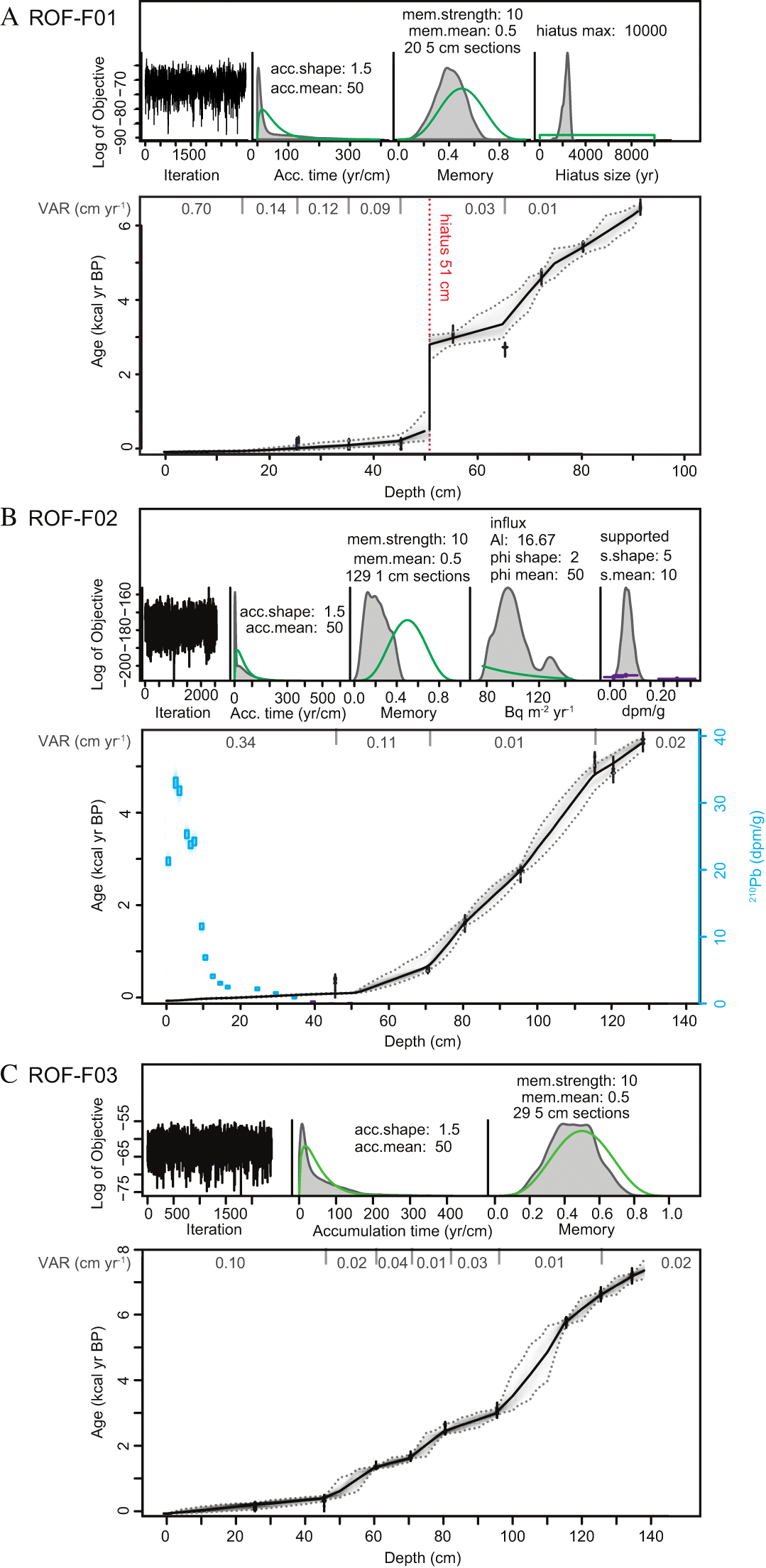
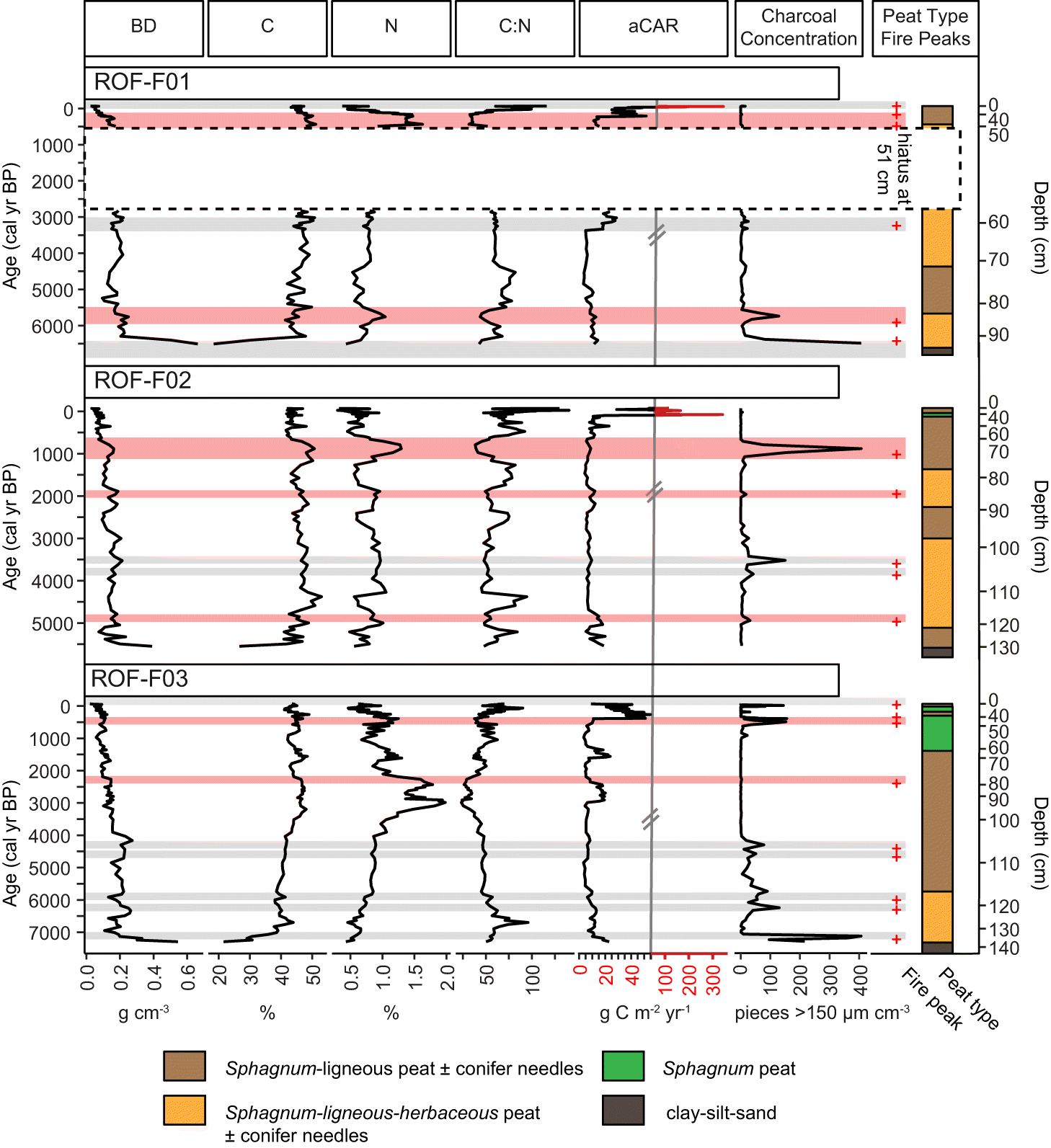
3.2. Charcoal accumulation rates, fire frequency, and potential carbon loss
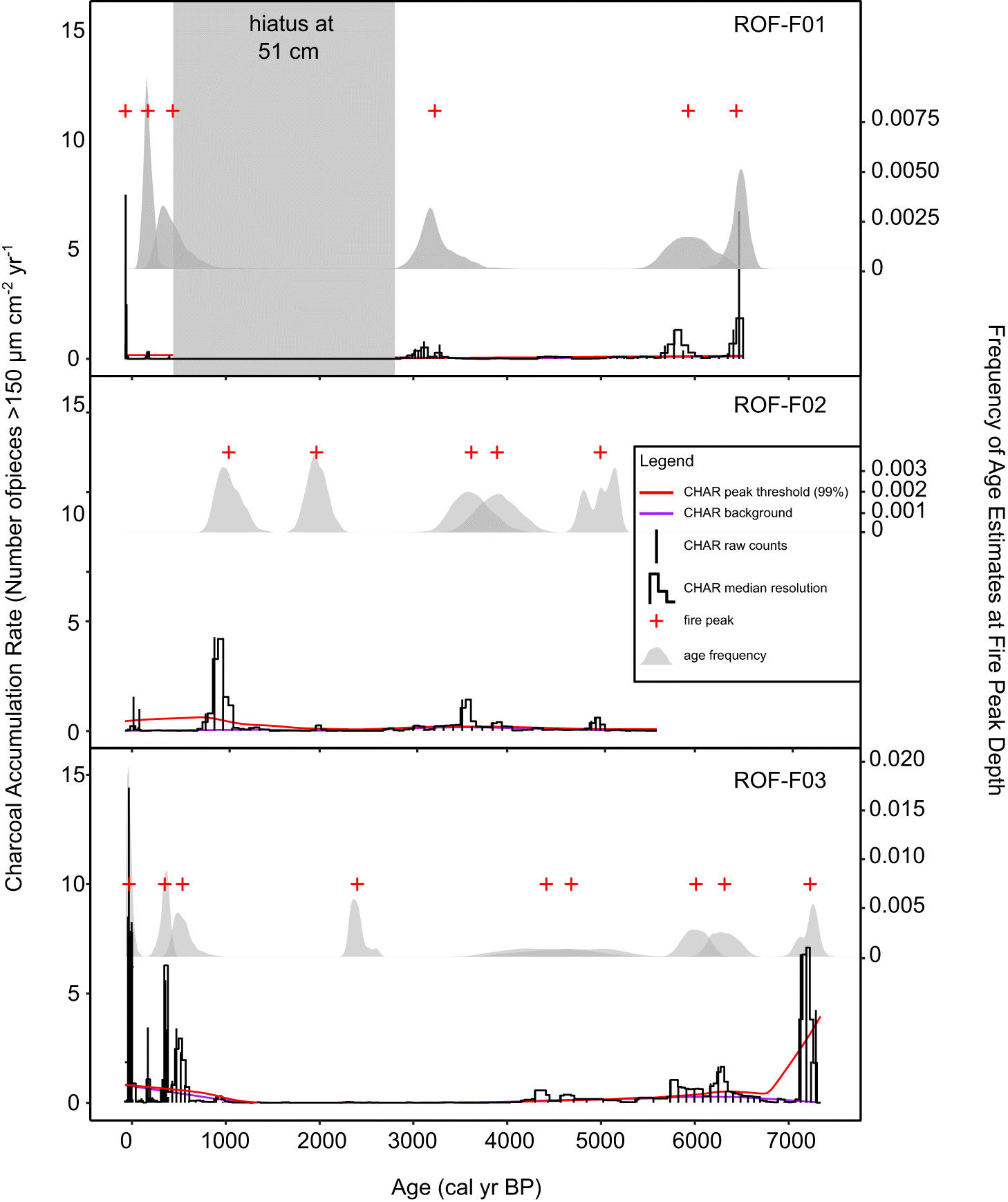
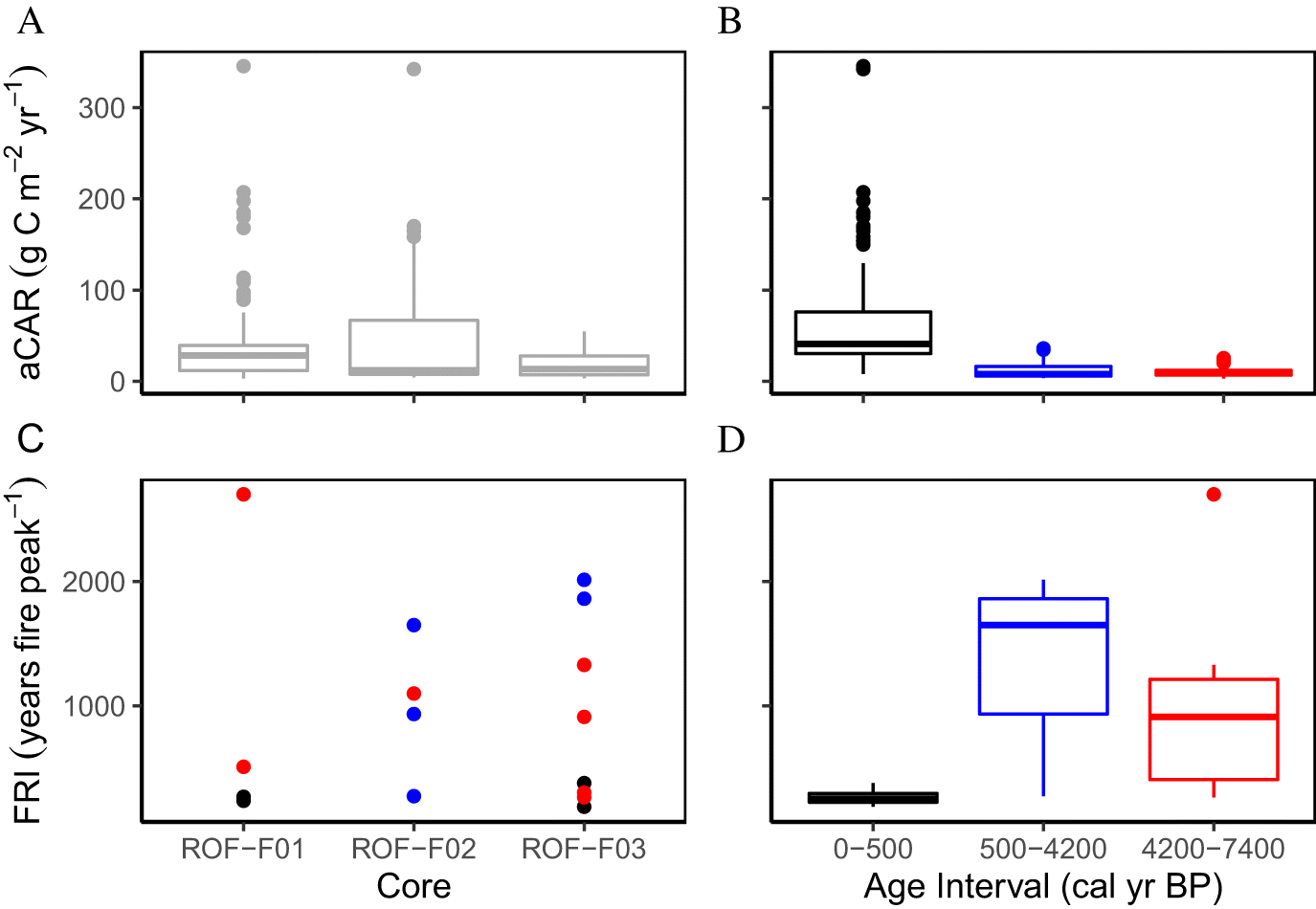
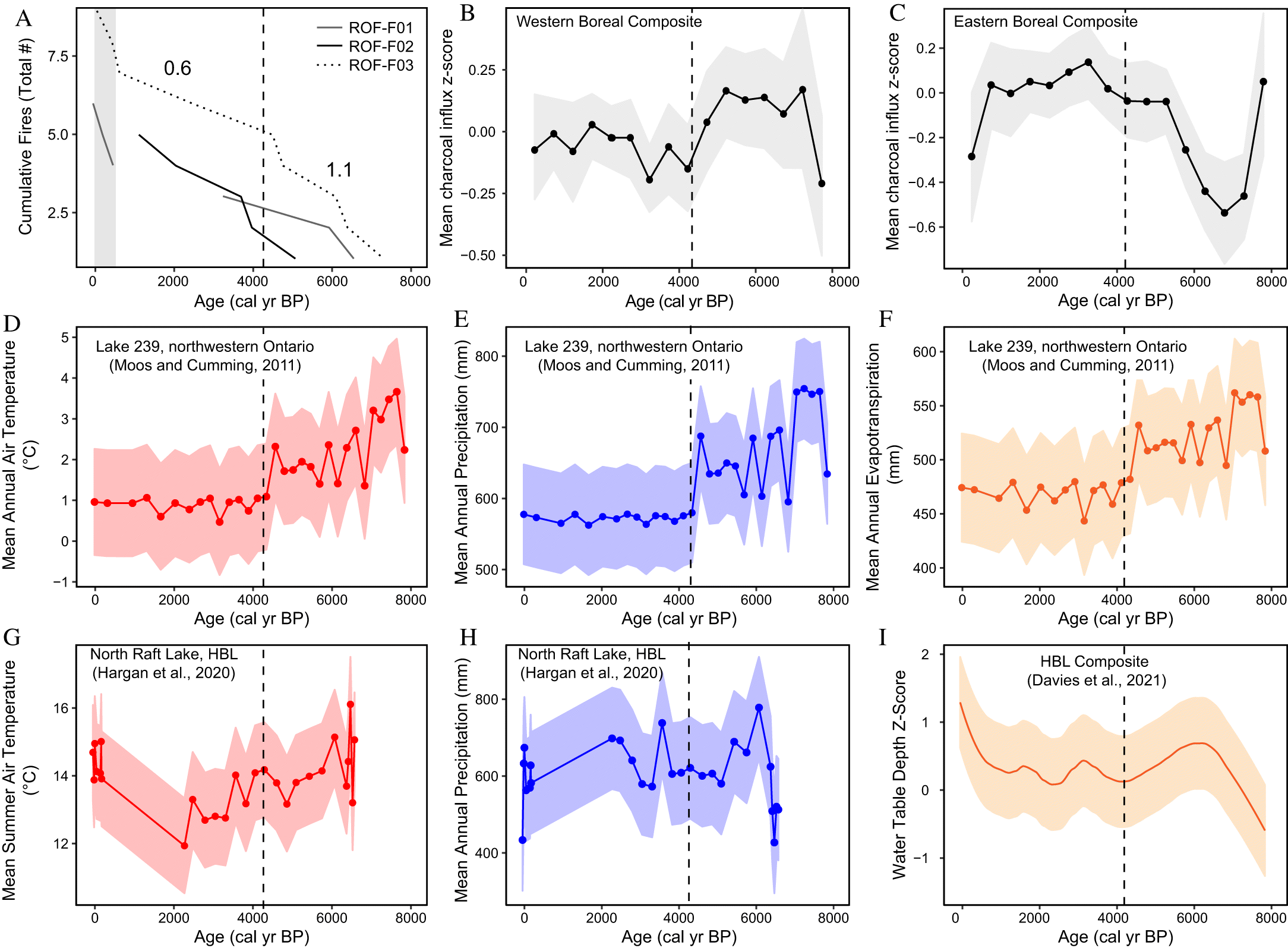
3.3. Relationship between fire frequency and carbon accumulation rates
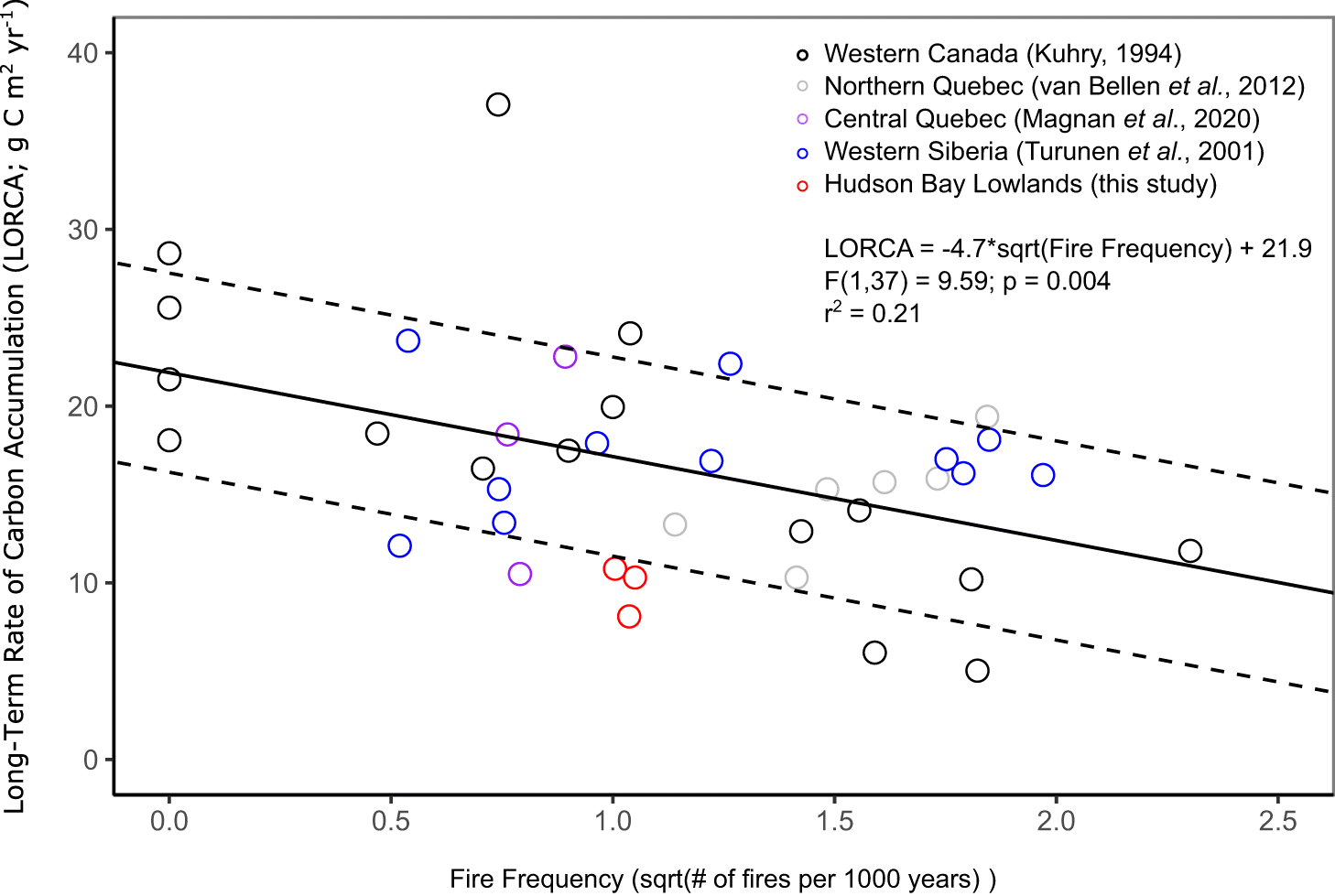
4. Discussion
4.1. Relationships between fire frequency and Holocene climate
4.2. Fire frequency impacts on peatland carbon cycling
5. Conclusions
Acknowledgements
References
Supplementary material
- Download
- 1.89 MB
Information & Authors
Information
Published In

History
Copyright
Data Availability Statement
Key Words
Sections
Subjects
Plain Language Summary
Authors
Author Contributions
Competing Interests
Metrics & Citations
Metrics
Other Metrics
Citations
Cite As
Export Citations
If you have the appropriate software installed, you can download article citation data to the citation manager of your choice. Simply select your manager software from the list below and click Download.
There are no citations for this item
